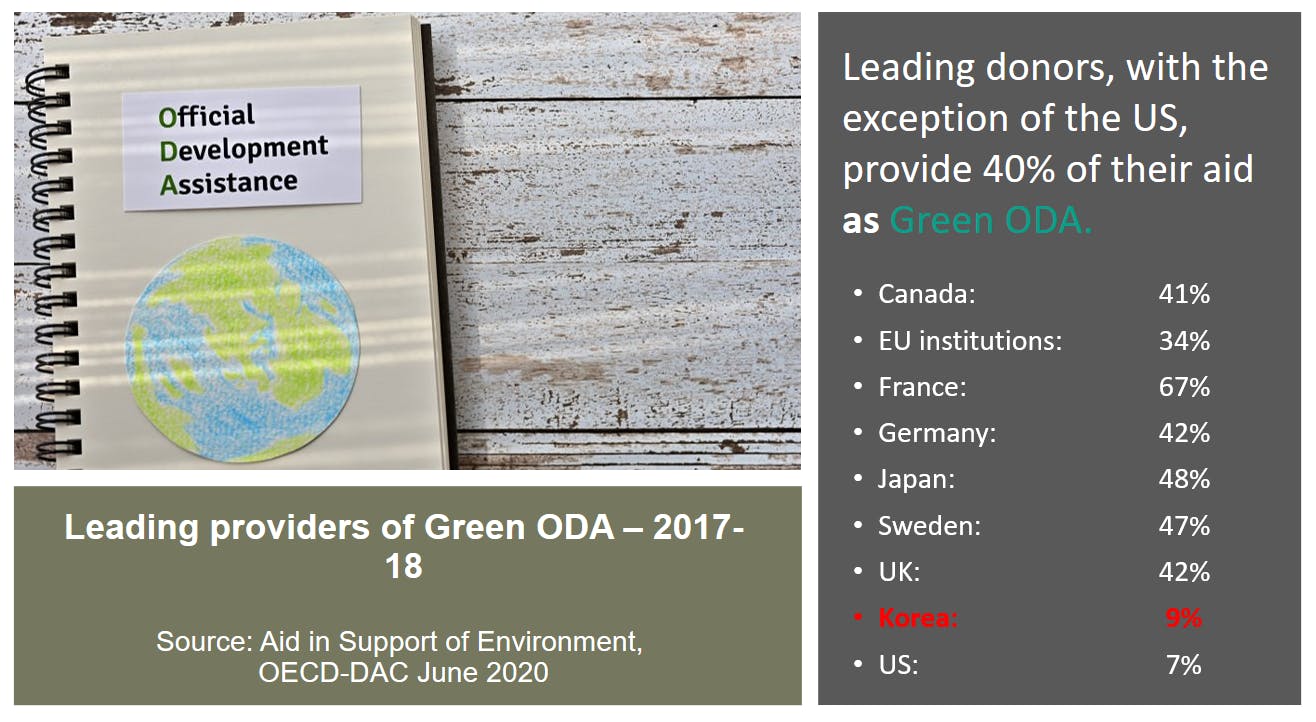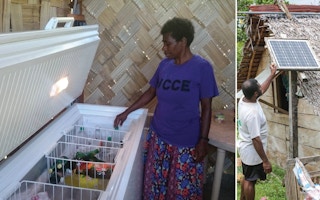“People living in the world’s poorest nations do not concern themselves with the environment, or the latest figures on carbon emissions; rather, they wake up each day wondering if they will be able to feed their children,” said Hazrat Mirza Masroor Ahmad, head of the Ahmadiyya Muslims Community.
Over the past 40 years that I have worked on environment and development issues, I have often heard statements like the quote above. Hungry people don’t care about the environment.
While this claim may be true, in the sense that poor people have many competing priorities, it should not be used as an excuse to ignore the environment and climate action in international development cooperation (Official Development Assistance, or ODA).
During that same period, the climate has evolved from an issue of primarily academic interest that might affect future generations, to the defining crisis of our time, particularly for poor people in developing countries.
Poor people in developing countries are most affected by pollution and climate change
While poor people may have many competing priorities, it has been demonstrated beyond doubt that poor people are also the most affected by air pollution, floods, droughts, cyclones, and climate change impacts generally.
Over 2 billion people do not have access to clean, sustainable energy for cooking, for example, and suffer from indoor air pollution as a result. The World Health Organisation estimates that air pollution causes seven million deaths each year, 1.6 million as a result of indoor air pollution – over half of those children under five years of age.
Of the 25 million climate refugees in 2019, the overwhelming majority were poor people in developing countries. Poor people in developing countries are aware of the climate crisis. A survey of farmers in South Africa in 2017 found that over 90 per cent was aware of climate change, more than two-thirds had experienced major climate events, and at least half had implemented response strategies themselves.
Poor people in developing countries are the least responsible for causing the climate crisis
They don’t own a car, don’t take flights, don’t use air-conditioning – in fact, two out of every three Africans do not even have access to electricity.
It is only fair that developed countries—that continue to emit the greenhouse gases that have caused the climate crisis—have committed to support developing countries to adapt to climate change. Rich countries have promised poor countries to transfer US$100 billion per year in climate finance.
Half of this money should focus on reducing emissions. The other half should focus on supporting poor people in developing countries to adapt to climate change, and avoid the worst impacts of floods, droughts, and cyclones, avoiding many millions more joining the ranks of the climate refugees.
Adaptation focused climate finance is lagging behind
While the total climate finance provided to developing countries rose to US$78.9 billion as estimated by the Organisation for Economic Co-operation and Development (OECD), 70 per cent of that went to reducing emissions (mitigation), and only 21 per cent to adaptation (with the remainder going to cross-cutting issues).
That US$16.8 billion focused on climate change adaptation is just peanuts compared with the US$10-12 trillion mobilised by governments to deal with the fall-out of the pandemic.
Some governments, like those in Europe and in the Republic of Korea, are using the opportunity to recover from the Covid-19 pandemic to “Build Back Better”.
This approach is to not just recreate what was there before the pandemic, but instead to use the opportunity to accelerate the transition to a greener economy and step up climate action. ‘Building back better’ is embodied in both the Green New Deal that the EU and Korea have announced, and the pledges to de-carbonise the economy and reach net-zero emissions by 2050, or earlier.
The pledge for net-zero is the best chance remaining for the world population to escape the worst climate change impacts.
Green growth opportunities to build back better
GGGI was established to support its member governments in this transition to a green growth development model. We are demonstrating to our members that a green recovery is in their best interests.
We have shown that implementing power sector pathways that are compatible with the nationally determined contributions (NDCs) to the Paris Agreement for emerging economies like Mexico and Indonesia can create millions of green jobs.
In other words, recovering from the pandemic can go hand-in-hand with stepping up the pace to net-zero by 2050.
Not only for the EU and Korea, but also for emerging economies such as Indonesia, Mexico, Philippines, Vietnam and Thailand—all key contributors of greenhouse gas emissions that have not yet bought into net-zero and are heavily relying on fossil fuels to power their economy.
For the least developed countries in Africa, or for the small island developing states in the Pacific and Caribbean, creating green jobs and becoming more resilient to climate change is a higher priority than reducing emissions.
But renewable energy is also a great technology to increase energy access for those two out of three Africans that still cook on open charcoal fires.
Renewable energy can bring solar-powered light and appliances such as fridges and freezers to off-grid hotels in small island hotels to grow their tourism business.
Escaping from poverty, reducing their indoor air pollution, and doing so in a low-carbon manner. For these countries, there are many other priorities that combine a green recovery with climate action – from solar-powered irrigation and climate-smart agriculture to rehabilitation of degraded ecosystems such as forests or peatlands.
GGGI is supporting twelve of its member countries this year with their plans and projects to green the recovery and, where possible, develop their own Green New Deal. We have developed recommendations for a model Green New Deal that is similar to those for the EU and Korea but has a much stronger focus on green jobs created through climate-smart agriculture and nature-based solutions.
Is ODA green?
The OECD tracks whether ODA is focused on the environment and climate change. It tracks 5 issues that overlap to a large extent: (1) environment; (2) climate mitigation; (3) climate adaptation; (4) biodiversity; and (5) desertification.
The total amount of bilateral development aid (not counting multilateral flows through the UN and similar) that focuses on the environment is US$35 billion of US$113 billion, or 31 per cent. The total supporting climate is US$29 billion, or 26 per cent (and remember that these two figures mostly overlap, they cannot be added up).
As noted above, only about 20 per cent of total climate finance (US$78 billion), or US$16.8 billion, focuses on adaptation, but as the private sector climate finance is almost exclusively focused on mitigation, it does follow that roughly half of all climate ODA is linked to adaptation.
Will ODA become greener as a result of Green New Deals?

Leading providers provide 40 per cent of their aid as green ODA, but Korea falls behind at only 9 per cent. Image: GGGI
Leading providers of green ODA are mostly European countries (France, 67 per cent; Germany 42 per cent; Sweden, 47 per cent; UK, 42 per cent), with Canada (42 per cent) and Japan (48 per cent).
The European Union institutions green ODA share was slightly above average, at 34 per cent, in 2018, but with the EU Green New Deal becoming the backbone of the green recovery for Europe and the “green growth strategy” across all EU policies, this is expected to increase.
The formal target for the green share of the EU’s ODA has not been set yet, but European development partners are arguing that it should be at least 50 per cent green, for both environment and climate finance combined.
How Green is Korea’s ODA? Not very green yet!
The environmental bilateral ODA provided by Korea stood at 10 per cent in 2018, against an OECD average of 33 per cent; and the climate finance amounted to 7 per cent, against an average of 26 per cent. The Korean ODA, in short, is far less green than the average, and lags even further behind the leading providers of green ODA, by a factor of over 4 times.
In the Conference on the Status and Prospects of the Green ODA of the Republic of Korea held on February 19, Vice President of KOICA Jae-Shin Park, did recognise that the green ODA of Korea should increase, and he indicated that it may double in years to come.
As can be seen from the numbers above, doubling the green ODA from Korea would be a good step, but it would keep Korea well below the average of other ODA providers, even in 2018, let alone the leading providers at that time—or the increased green share that we may expect to see out of the EU institutions.
Recommendations to Green Korea’s ODA
To green Korea’s ODA in line with its leadership on a Green New Deal and its net-zero 2050 pledge, this author recommends the following:
- Increase the green ODA target to 50 per cent. The green ODA (environment and climate finance combined) of the Republic of Korea, counting all sources, KOICA, KDB, Exim Bank and Ministries should at a minimum be increased to the average of other OECD ODA providers (i.e. 31 per cent in 2018), and as Korea aims to be a leader in Green New Deal and net-zero related policies that percentage should increase to well over 40 per cent, as other leading providers already achieved in 2018. True leadership from Korea would be reflected in a target of 50 per cent green ODA by 2050, or about five times the current share.
- Prevent harmful spending. Korean ODA programming instructions should include an obligation that 100 per cent of programs are climate/environment-proof and resilient. That implies that Korea should no longer finance any fossil fuel projects internationally, for example.
- Apply standards. Korean ODA should apply standards for Environmental Impact Assessments and Climate Risk Assessments for all ODA projects.
Implementing these three recommendations offers the Republic of Korea the opportunity to transform its position from a green ODA laggard to a Green ODA leader.
Frank Rijsberman is Director-General at Global Green Growth Institute (GGGI).


















